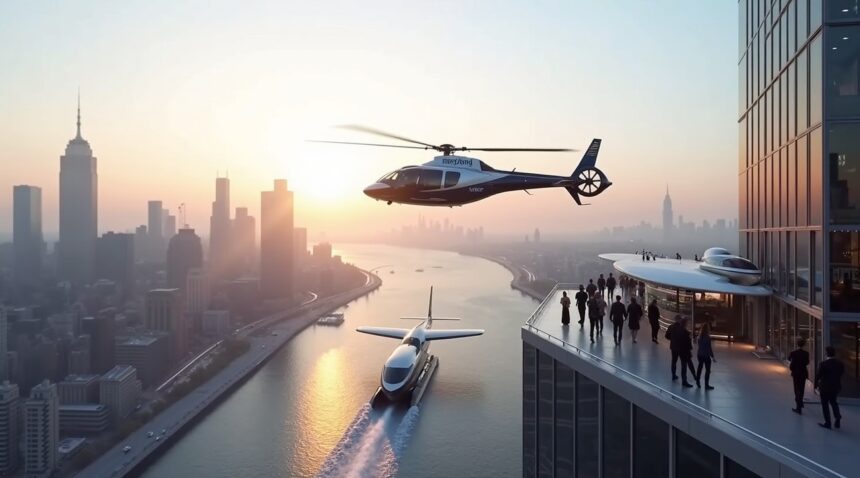Uber is evolving beyond traditional ride-sharing to become a full-fledged transportation hub with the introduction of helicopter and seaplane bookings through its app, made possible by strategic partnerships with Blade and Joby Aviation.
Key Takeaways
- Helicopter and seaplane bookings will be integrated into the Uber app by 2026, with individual seats from $195 and full charters beginning at $2,000 for up to 8 passengers.
- Initial service areas include New York City and Southern Europe, with future expansions planned for Los Angeles, Dubai, the UK, and Japan, utilizing Blade’s existing infrastructure of landing pads and passenger lounges.
- Joby Aviation’s $125 million acquisition of Blade’s passenger business facilitated the foundation of this partnership, aligning with Uber’s goal to become a multi-modal transport solution provider.
- Electric vertical takeoff and landing (eVTOL) aircraft will gradually replace helicopters post FAA certification, offering zero emissions, speeds of 200 mph, and significantly quieter operation.
- Travel efficiency will drastically improve, with routes like Manhattan to JFK reduced from over one hour to just five minutes by helicopter—a 92% time savings.
The integration of air travel into the Uber platform builds upon Blade’s seasoned network of heliports and passenger terminals. Pricing is set to attract both business and luxury travelers, with helicopter seat fares beginning at $195 and private air charters starting from $2,000 for groups of up to eight passengers.
Joby Aviation & Blade Partnership
Joby Aviation’s pivotal acquisition of Blade’s passenger operations for $125 million provides the technological groundwork for this initiative. Joby’s electric aircraft, once certified, will replace helicopters, delivering cleaner, faster, and quieter urban air mobility.
Electric Air Taxis: The Future of Urban Aviation
These advanced eVTOL aircraft promise:
- Zero emissions, supporting sustainable transportation goals.
- Top speeds of 200 mph, significantly reducing long urban commutes.
- Noise levels 100 times quieter than traditional helicopters, minimizing community impact.
Strategic Rollout and Market Expansion
The service debuts in New York City and Southern Europe, later reaching Los Angeles, Dubai, Japan, and the UK. Blade’s extensive infrastructure in these cities enables Uber to deploy air services with fewer logistical challenges.
Flagship Route: Manhattan to JFK
The signature offering—Manhattan to JFK in only five minutes—appeals directly to time-sensitive travelers, notably business executives and high-net-worth individuals who value speed and convenience over cost.
Consolidating Transportation Services
The partnership reflects Uber’s transformation into a comprehensive mobility platform, offering everything from ground transport to premium air travel via one app interface. This shift also boosts cross-selling potential between different travel modes.
Certification & Infrastructure Dependencies
Widespread adoption hinges on FAA certification of electric aircraft and the ability to scale supporting infrastructure. Blade’s current assets—comprising landing pads and premium lounges—provide a critical starting point. Further growth will require close collaboration with city planners and airport authorities.
Target Market & Competitive Edge
The air service targets affluent users and corporate clients, offering a luxury experience that dramatically saves time. Uber’s existing customer base and app ecosystem provide a sharp competitive advantage, allowing it to bypass many of the costs faced by standalone aviation startups.
Revenue Outlook & Business Viability
While premium pricing brings in higher margins, overall adoption and route frequency will determine profitability. Balancing service availability with efficient aircraft utilization remains key to scalability and sustainability in various markets.
This collaboration signifies a bold leap in urban transportation—marrying Uber’s established technology with rapidly advancing aviation solutions. It carves a new mobility frontier for customers demanding efficient, premium transport services. To stay updated, you can explore more about Uber’s latest initiatives and learn about Joby Aviation’s progress with electric aircraft.
Helicopter Rides in Your Uber App: The $195 Airport Transfer Revolution
By 2026, I’ll be able to book helicopter and seaplane flights directly through the Uber app, thanks to an exciting partnership with Joby Aviation and the integration of Blade’s air passenger services. This revolutionary development transforms how users access premium air transportation, making helicopter rides as simple as requesting a standard car ride.
The integration brings Blade’s extensive network of landing points and lounges directly into the familiar Uber interface. Users can arrange helicopter and seaplane rides with the same ease they’ve come to expect from regular Uber trips. This seamless experience eliminates the complexity traditionally associated with booking air transportation services.
Pricing and Flight Options
The service offers two distinct booking options to accommodate different needs and budgets:
- Individual seat bookings start at $195 per passenger, making helicopter travel more accessible than ever before
- Full helicopter charters begin at $2,000 and can accommodate up to 8 passengers for larger groups or private travel
- Seaplane options provide alternative routes and scenic travel experiences through the same booking system
These flights deliver remarkable time savings for busy travelers. A helicopter ride between Manhattan and JFK Airport takes just five minutes, compared to an hour or more by car during peak traffic. This dramatic reduction in transit time makes the premium pricing worthwhile for time-sensitive travelers and business professionals.
The partnership represents a significant step forward in urban air mobility, similar to how self-driving cars are revolutionizing ground transportation. While we’ve seen innovations like flying car debuts and commercial space flights, this helicopter service integration offers immediate practical value for everyday travelers.
Blade’s established infrastructure provides the foundation for this service expansion. Their existing network of helipads and passenger lounges ensures users can access professional, reliable air transportation without the traditional barriers of private aviation. The company’s experience in managing helicopter operations brings operational expertise that complements Uber’s platform technology.
The service targets frequent travelers who value time over cost, particularly those making regular trips between city centers and airports. Business travelers will find the helicopter option especially appealing during rush hours or weather-related delays that affect ground transportation. The convenience of booking through a familiar app interface removes friction from what was previously a specialized service requiring separate booking platforms and payment systems.
From Manhattan to JFK in 5 Minutes: Routes and Service Details
The new Uber air travel booking feature transforms how passengers approach airport transfers and urban commutes through strategic route planning. Users can book flights connecting Manhattan to JFK, Newark Liberty International Airport, and the Hamptons directly through the familiar Uber interface. These aerial routes slash travel times dramatically, offering 5- to 7-minute flights compared to ground commutes that often stretch beyond an hour.
Strategic Market Expansion and Route Development
Uber’s partnership with Blade brings proven aviation infrastructure to the platform. In 2024 alone, Blade transported 50,000 passengers across the New York metro area and Southern Europe, demonstrating substantial demand for premium air travel services. The service rollout begins in New York City and Southern Europe before expanding into high-demand markets including Los Angeles, Dubai, the UK, and Japan.
The established network includes several key advantages that enhance the passenger experience:
- Luxurious passenger lounges at departure points provide comfortable waiting areas
- Strategic landing pad locations at urban centers and major airports
- Streamlined boarding processes designed for quick turnarounds
- Professional flight crews experienced in urban aviation operations
Blade’s existing infrastructure eliminates many startup challenges typically associated with new aviation services. The company’s network of landing facilities positions aircraft close to business districts and transportation hubs, maximizing convenience for time-sensitive travelers. This strategic positioning allows passengers to avoid lengthy ground transfers that often accompany traditional aviation services.
The time savings prove particularly valuable for business travelers and luxury consumers who prioritize efficiency. A typical Manhattan to JFK journey by car can range from 45 minutes to over 90 minutes depending on traffic conditions. The aerial alternative consistently delivers passengers in under 10 minutes, regardless of ground congestion.
While self-driving cars continue developing, air travel offers immediate solutions for urban mobility challenges. The service complements rather than competes with ground transportation, providing premium options for specific high-value routes where time savings justify the cost premium.
Future expansion plans indicate Uber’s commitment to scaling air travel booking beyond initial markets. The company’s global platform provides access to millions of potential customers, while Blade’s operational expertise ensures service quality and safety standards. This combination positions the partnership for significant growth as urban air mobility becomes more mainstream and regulations continue evolving to support commercial helicopter and seaplane operations in major metropolitan areas.
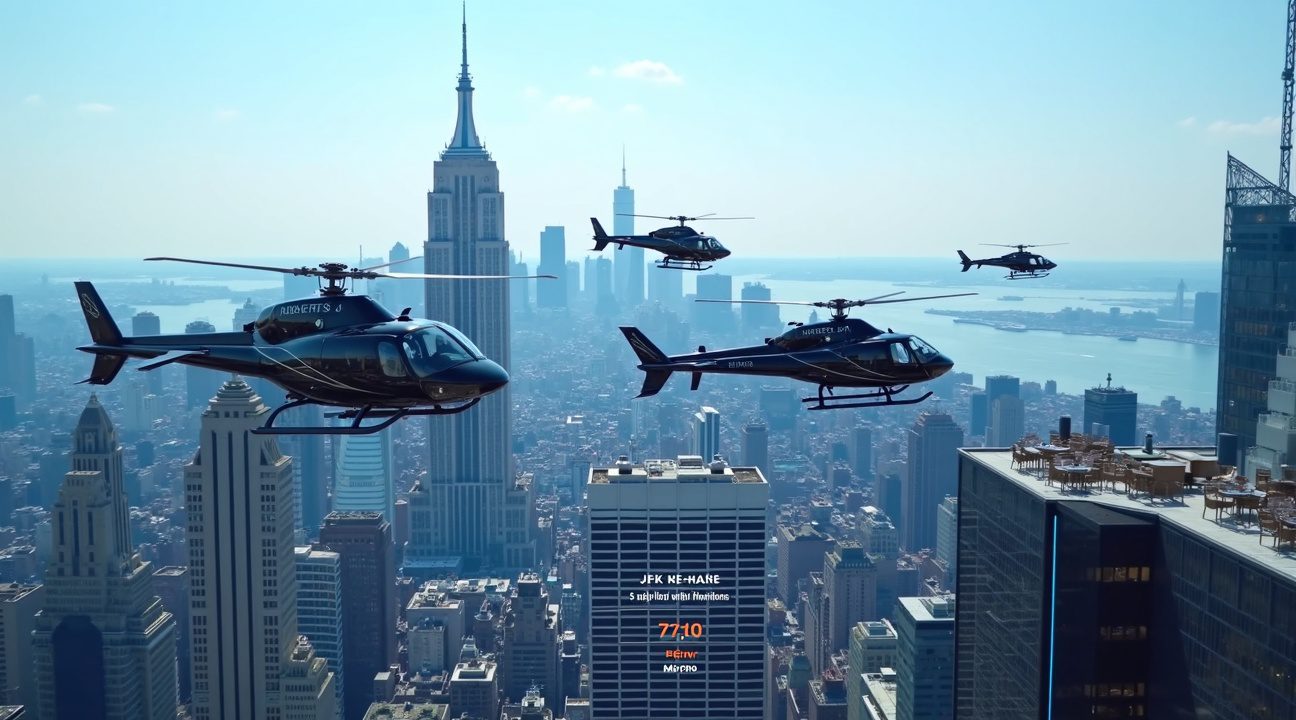
The $125 Million Deal Behind Uber’s Sky-High Ambitions
Uber’s ambitious leap into aerial transportation stems from a strategic acquisition that reshaped the air mobility landscape. Joby Aviation’s $125 million purchase of Blade’s passenger business in August 2025 created the foundation for Uber’s helicopter and seaplane booking capabilities.
The market responded swiftly to this announcement. Joby Aviation shares climbed 3.7% immediately following the news, while Uber’s stock experienced a modest decline. This mixed reaction reflects investor uncertainty about Uber’s expansion strategy, even as the deal positions the company for significant growth in premium transport services.
Building the Ultimate Transportation Platform
This acquisition supports Uber’s vision of becoming a comprehensive ‘super app’ that connects users to every form of urban mobility. The platform will soon integrate multiple transport options seamlessly:
- Air travel through helicopters and seaplanes
- Traditional ride-hailing services
- Bike and scooter sharing programs
- Electric vehicle options
- Public transit connections
The integration transforms Uber from a simple ride-hailing service into a complete mobility ecosystem. Users can now plan journeys that combine ground and air transportation without switching between multiple apps or platforms.
Joby Aviation brings proven expertise in electric vertical takeoff and landing aircraft, while Blade’s established passenger operations provide immediate access to helicopter and seaplane networks. This combination eliminates years of development time that Uber would have needed to build these capabilities independently.
The move addresses growing demand for faster urban transportation as cities become increasingly congested. High-speed, semi-luxury air transport will no longer remain exclusive to wealthy individuals or corporate executives. Millions of Uber users worldwide will gain access to these premium services through familiar booking interfaces.
I expect this diversification strategy to accelerate as transportation technology advances. Self-driving cars represent just one facet of Uber’s technological evolution. The company’s commitment to multi-modal transport solutions positions it ahead of competitors who focus solely on ground-based services.
The timing aligns with broader trends in urban air mobility. Companies across the industry are racing to commercialize flying car technologies and aerial taxi services. Uber’s partnership approach allows rapid market entry without the massive research and development investments required for aircraft manufacturing.
This strategic acquisition demonstrates how traditional transportation boundaries continue to blur. The same app that currently connects users to nearby drivers will soon coordinate complex multi-modal journeys involving ground vehicles, helicopters, and seaplanes.
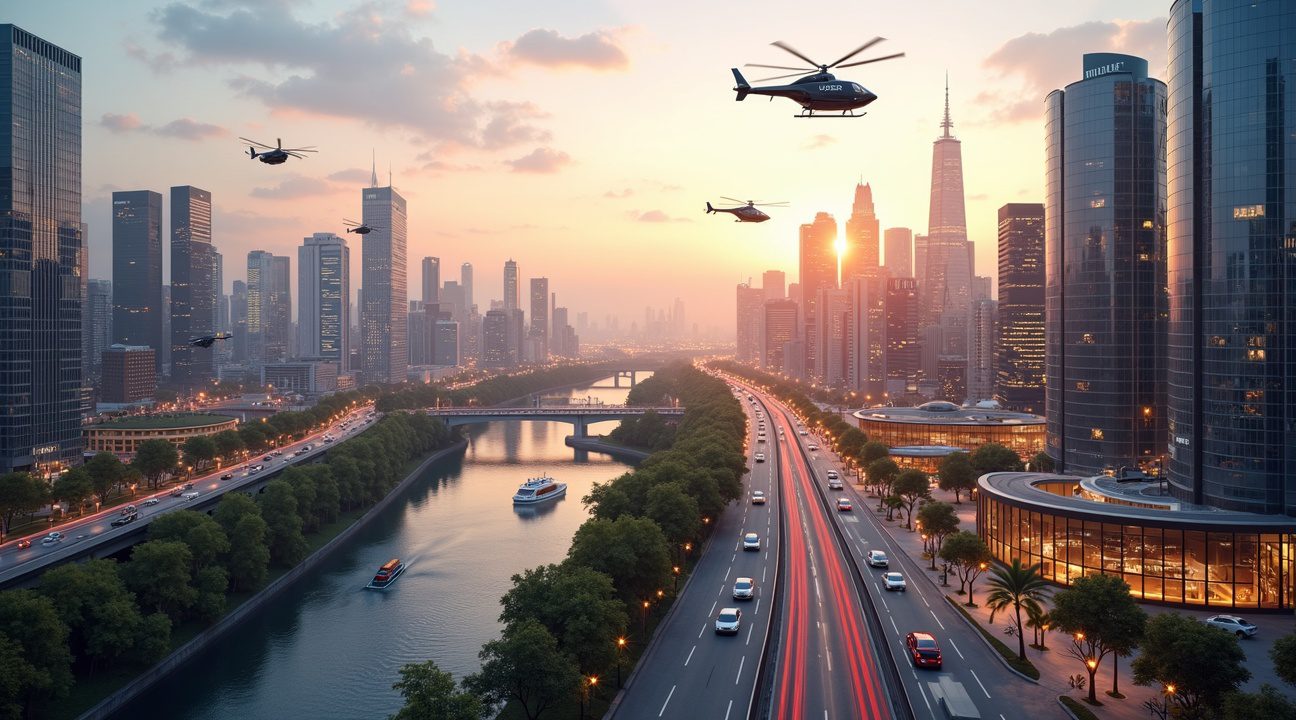
Electric Air Taxis Will Replace Today’s Helicopters
I find it fascinating that today’s helicopter bookings through Uber will eventually transform into something far more revolutionary. The partnership between Uber, Blade, and Joby Aviation represents just the beginning of a fundamental shift in urban air transportation.
Joby Aviation’s Electric Aircraft Technology
Joby Aviation’s electric vertical takeoff and landing aircraft will replace conventional helicopters once they receive FAA certification. These eVTOL aircraft represent a significant technological leap forward, offering capabilities that surpass traditional helicopters in multiple ways.
I’m impressed by the specifications Joby has achieved. Their aircraft will accommodate four passengers plus a pilot, reach speeds up to 200 mph, and produce zero emissions during operation. Perhaps most remarkably, these electric air taxis will operate with noise levels 100 times quieter than current helicopters. This dramatic noise reduction addresses one of the biggest barriers to widespread urban air mobility adoption.
The aircraft’s design eliminates the need for fossil fuels entirely, relying instead on electric propulsion systems. This approach aligns with growing environmental consciousness and regulatory pressure to reduce aviation emissions. Unlike traditional helicopters that burn jet fuel continuously, Joby’s eVTOLs draw power from rechargeable battery systems.
The Transition from Turbine to Electric Power
Blade’s current fleet operates with turbine-powered aircraft, but the company is actively transitioning to Joby’s electric aircraft as they become operationally available. This transition period allows passengers to experience helicopter services immediately while the infrastructure for electric air taxis develops.
I see this gradual transition as a smart business strategy. Blade maintains service continuity using existing helicopter technology while preparing for the electric future. The company can refine operational procedures, train pilots, and establish safety protocols using current aircraft before switching to eVTOLs.
The shift supports Uber’s broader sustainability initiatives across all transportation modes. The company is already implementing decarbonization strategies through solar energy-powered electric vehicles in Europe. Adding zero-emission air travel to their platform creates a comprehensive sustainable transportation ecosystem.
Electric air taxis will fundamentally change urban mobility patterns:
- Reduce traffic congestion by utilizing vertical takeoff and landing
- Decrease noise pollution in densely populated areas
- Provide faster point-to-point travel for short to medium distances
- Potentially lower operating costs and make air mobility more accessible
The timeline for this transition depends on regulatory approval and infrastructure development. FAA certification remains the critical milestone before commercial eVTOL operations can begin. Additionally, charging infrastructure must be established at landing sites to support electric aircraft operations.
I expect the initial rollout will target high-demand routes between airports and city centers, similar to current helicopter services. As the technology proves itself and infrastructure expands, routes will diversify to include intracity travel, medical transport, and emergency services. The quiet operation of electric aircraft will enable landing sites in areas where helicopter noise currently prohibits operations.
Manufacturing scale will also influence adoption speed. Joby must produce enough aircraft to meet demand while maintaining safety standards. The company’s ability to deliver on production timelines will determine how quickly Uber users can access electric air taxi services.
This evolution from conventional helicopters to electric aircraft represents more than just technological advancement. It signals a transformation in how people think about urban transportation, environmental responsibility, and the future of mobility. The integration of these services into familiar platforms like Uber makes advanced transportation technology accessible to everyday users, potentially accelerating adoption and acceptance.
The combination of zero emissions, reduced noise, and enhanced safety features positions electric air taxis as the natural successor to today’s helicopter services. I believe this technology will eventually make urban air mobility as common as ride-sharing is today.
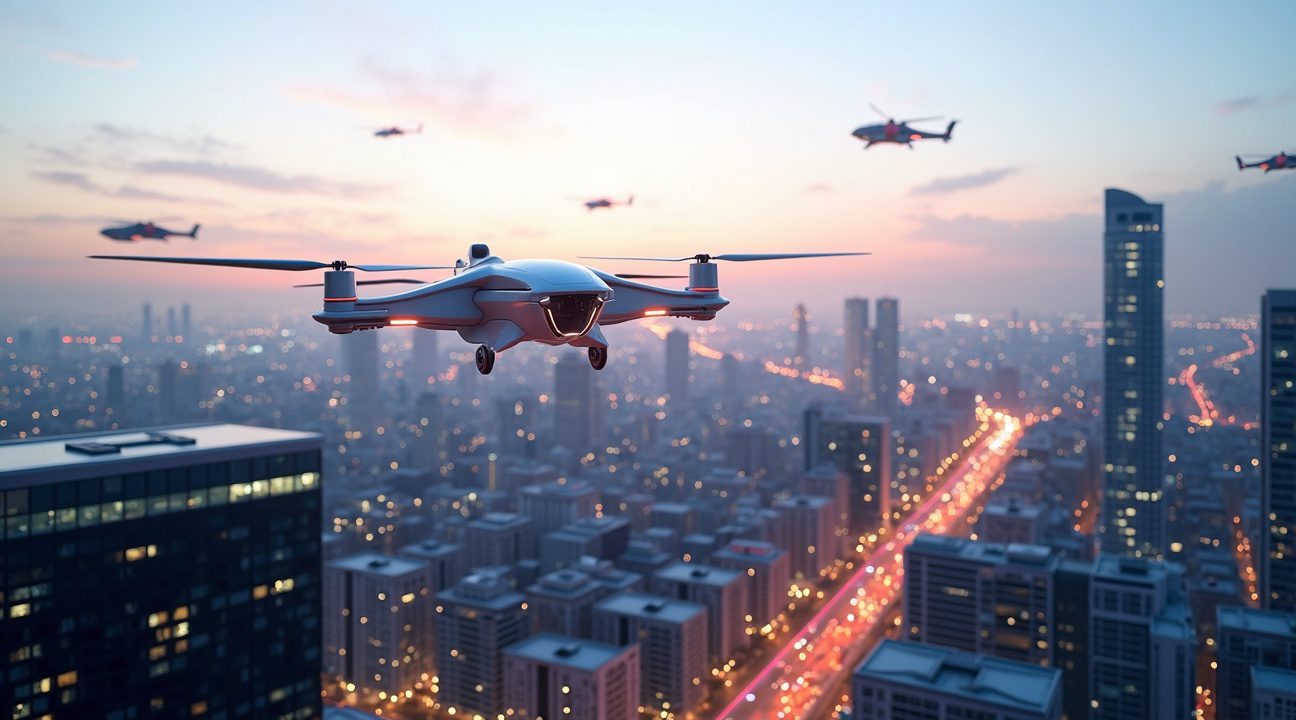
Luxury Air Travel Enters the Ride-Share Era
Uber’s partnership with Blade transforms the ride-share giant into a comprehensive transportation super app, offering helicopter and seaplane bookings directly through its familiar interface. This integration brings premium air travel options to millions of users who previously relied solely on ground-based transportation methods.
Breaking the Ground Transportation Barrier
Traditional urban transit options like taxis, trains, and standard ride-share vehicles can’t compete with the point-to-point efficiency of air travel. Self-driving cars may revolutionize ground transport, but they still face the same traffic congestion and route limitations that plague conventional vehicles. Uber seaplanes and helicopters bypass these constraints entirely, creating direct aerial corridors between destinations.
The time savings prove particularly dramatic for airport transfers. A helicopter ride from Manhattan to JFK takes just five minutes, while ground methods frequently require over an hour during peak traffic periods. This represents a 92% reduction in travel time, making the premium pricing structure more justifiable for time-conscious travelers.
Premium Positioning Within the App Ecosystem
These luxury urban transfer options position Uber as more than a standard ride-share platform. The company now competes directly with private aviation services while maintaining the convenience of app-based booking that users already trust. Business travelers, affluent commuters, and tourists seeking unique experiences represent the primary target demographics for these services.
The helicopter and seaplane integration follows broader trends in transportation innovation. Just as flying cars make their debut in various markets, and commercial space flights prepare for curious travelers, Uber positions itself at the forefront of next-generation mobility solutions.
Air vs ground commute comparisons reveal the true value proposition of these services. While a standard Uber ride from Lower Manhattan to Newark Airport costs around $50-70 and takes 45-90 minutes depending on traffic, the helicopter alternative completes the journey in under 10 minutes. The premium pricing reflects not just the luxury experience, but the measurable time savings that can’t be achieved through any ground-based alternative.
This expansion strategy demonstrates Uber’s evolution from a simple car-booking app into a comprehensive mobility platform. By 2026, users will seamlessly switch between cars, helicopters, and seaplanes within a single application, fundamentally changing how people think about urban transportation options.
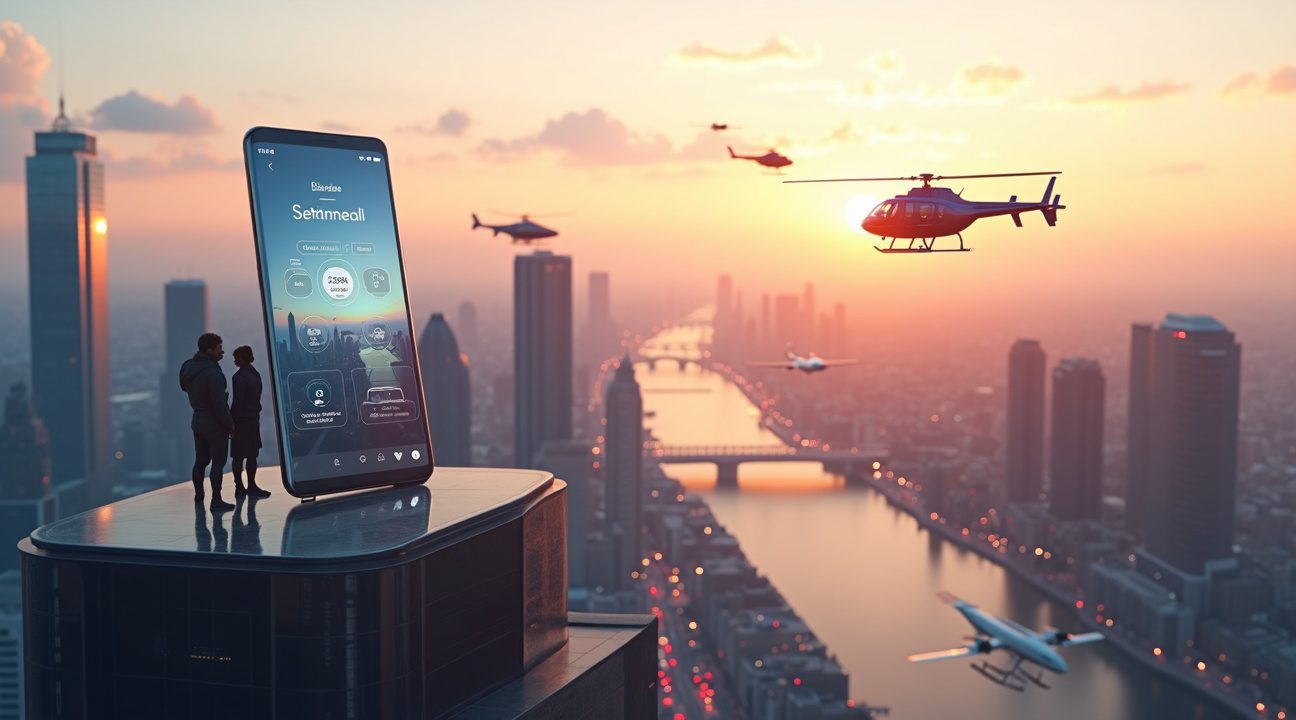
Sources:
AINvest – “Uber to Integrate Blade’s Air Passenger Services Into App in 2026”
Time Out – “Next Year, Uber App Offers Blade Helicopter and Seaplane Bookings”
CBS News – “Uber Plans to Let Customers Book Helicopter Rides Through Its App”
The Jerusalem Post – “Uber turning into super app with Joby helicopter, Blade deal”
AINonline – “Uber Ride-share App to Offer Helicopter Flights Brokered by Blade”

